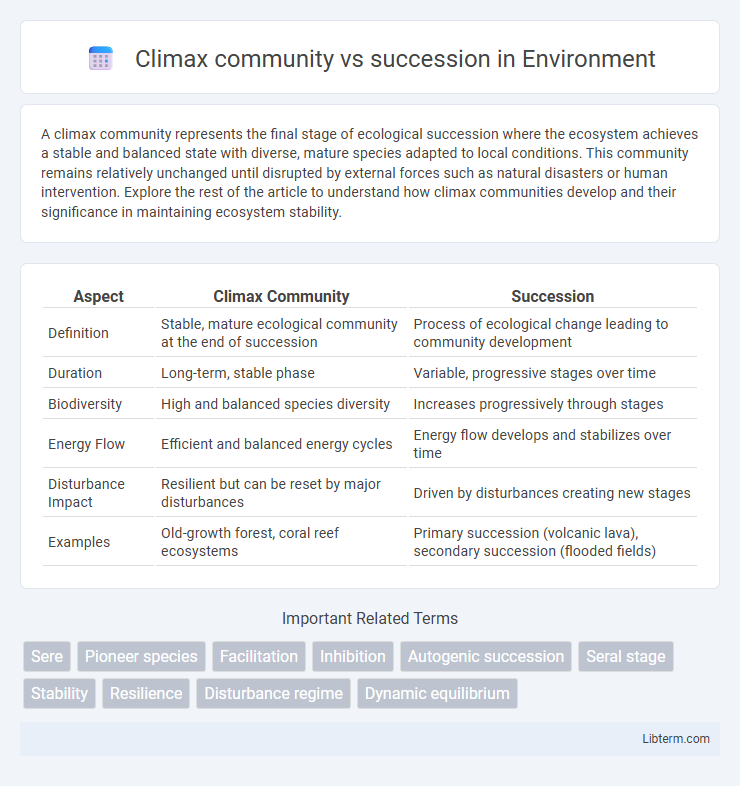A climax community represents the final stage of ecological succession where the ecosystem achieves a stable and balanced state with diverse, mature species adapted to local conditions. This community remains relatively unchanged until disrupted by external forces such as natural disasters or human intervention. Explore the rest of the article to understand how climax communities develop and their significance in maintaining ecosystem stability.
Table of Comparison
| Aspect | Climax Community | Succession |
|---|---|---|
| Definition | Stable, mature ecological community at the end of succession | Process of ecological change leading to community development |
| Duration | Long-term, stable phase | Variable, progressive stages over time |
| Biodiversity | High and balanced species diversity | Increases progressively through stages |
| Energy Flow | Efficient and balanced energy cycles | Energy flow develops and stabilizes over time |
| Disturbance Impact | Resilient but can be reset by major disturbances | Driven by disturbances creating new stages |
| Examples | Old-growth forest, coral reef ecosystems | Primary succession (volcanic lava), secondary succession (flooded fields) |
Introduction to Climax Community and Succession
Climax community represents a stable and mature ecological state where species composition remains relatively constant over time, following the process of ecological succession. Succession is the gradual, directional change in species composition and ecosystem structure that occurs after a disturbance or the creation of new substrate. Understanding the dynamics of succession helps explain how ecosystems develop towards a climax community characterized by high biodiversity and equilibrium.
Defining Climax Community
A climax community represents a stable and mature ecosystem that has reached the final stage of ecological succession, where species composition remains relatively unchanged over time. This community is characterized by a balanced structure, high biodiversity, and efficient nutrient cycling, indicating environmental equilibrium. Succession describes the dynamic process of ecological change leading to this climax state, involving progressive species replacement and habitat modification.
Understanding Ecological Succession
Ecological succession describes the gradual process by which ecosystems change and develop over time, leading to shifts in species composition and community structure. A climax community represents the final, stable stage of succession, characterized by a balanced and mature ecosystem with relatively constant species populations. Understanding ecological succession involves recognizing how pioneer species colonize disturbed areas, facilitating transitions through intermediate stages until the climax community is established.
Stages of Succession
Stages of succession include primary succession, starting on lifeless areas like lava flows, and secondary succession, occurring after disturbances in established ecosystems. Early stages feature pioneer species that prepare the environment for subsequent communities, followed by intermediate stages where biodiversity increases and soil quality improves. The climax community represents the final, stable stage where species composition remains relatively constant unless disrupted.
Characteristics of a Climax Community
A climax community exhibits stability, high biodiversity, and balanced species interactions, representing the final stage of ecological succession. It maintains equilibrium through complex food webs, nutrient cycling, and resistance to environmental disturbances. Species composition remains relatively constant, with dominant plants and animals adapted to local climatic and soil conditions.
Primary vs. Secondary Succession
Primary succession occurs on newly formed or exposed land surfaces devoid of soil, such as lava flows or glacial retreats, leading to a gradual development of a climax community, which is a stable and mature ecosystem. Secondary succession takes place in areas where a previously existing community has been disturbed or removed, like forest fires or floods, allowing ecosystems to recover faster since soil and seed banks remain intact. Climax communities represent the final stage of both primary and secondary succession, characterized by biodiversity equilibrium and sustained species composition adapted to local environmental conditions.
Factors Affecting Succession and Climax
Factors affecting succession include climate, soil composition, disturbance frequency, and availability of species seeds, which collectively influence the trajectory and pace of ecological change. A climax community represents a stable, mature ecosystem with balanced species composition, shaped by long-term environmental conditions and minimal disturbance. Changes in temperature, moisture, nutrient availability, and human intervention can alter succession pathways and prevent or shift the establishment of a climax community.
Human Impact on Succession and Climax Communities
Human impact significantly alters the natural progression of ecological succession and the stability of climax communities by introducing pollutants, deforestation, and urban development. These disturbances reset successional stages, prevent ecosystems from reaching a climax community, and reduce biodiversity while increasing habitat fragmentation. Restoration efforts aim to mitigate human effects, promoting succession toward a resilient climax community that supports diverse species and ecosystem functions.
Climax Community Examples in Different Biomes
Climax communities represent the final, stable stage of ecological succession, characterized by a diverse and self-sustaining array of species adapted to local environmental conditions. Examples include old-growth deciduous forests in temperate regions, tropical rainforests in equatorial zones, and boreal coniferous forests in subarctic areas. Each biome's climax community exhibits unique species compositions and structural complexity, reflecting long-term ecological stability and minimal disturbance.
Succession and Climax: Ecological Significance and Future Perspectives
Succession drives ecosystem development through gradual species replacement, leading to a climax community that represents ecological stability and maximum biodiversity for a given environment. Climax communities serve as benchmarks for understanding long-term ecological balance, nutrient cycling, and habitat complexity, providing crucial insights for conservation and restoration efforts. Future research emphasizes the impact of climate change and human activities on successional pathways and climax community resilience, aiming to predict and manage ecosystem responses to environmental disturbances.
Climax community Infographic

 libterm.com
libterm.com